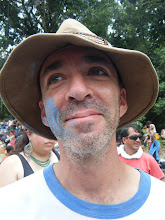Warning: This post contains some photos of dead livestock. However, unless you are a card carrying member of PETA and a vegan you really have no excuse not to look at them.
Besides checking out the burial sites and the picturesque rice field landscapes the other attraction (and main reason most people visit) in Tana Toraja is to attend a funeral ceremony. The Torajan people are predominately Christian, but the ceremonies are a strong reminder of Aluk Todolo - the religion before the missionaries came. The funerals are large, elaborate ceremonies lasting several days where hundreds of people can attend and need to be fed. The ceremonies are also notorious for their honest-to-goodness animal sacrifices of water buffaloes and pigs.
Funerals take place in the dry season from July - September. So logically you may ask , “Well what happens if Grandpa dies in the rainy season, January for example?” Good question. Well, Grandpa will stay in the house in an open casket in a mummified state until his family has saved enough money to have a big send-off and until the right season begins. We do not see this on our trip. However, I do see another traveler’s photo of his guide’s Grandmother who is patiently waiting for her big day. She has been in a coffin in the house for 10 months already.
Arriving to Tana Toraja in mid-September is actually a perfect time. It is still peak ceremony season, but most of the tourist hordes have already returned to Western Europe which means foreigners are not tripping over each other to get that perfect shot of an animal carcass. As usual, we first decide to try to find a ceremony ourselves and get there by using public transportation. The guides do want to divulge much to people not rendering their services. There are so many Torajan villages in the area and trying to pin down exact info in Indonesia can sometimes be like channel surfing - 250 options and still not sure if anything is good on TV.
 |
| A procession |
 |
| The deceased in the coffin watching the action below |
Immediately, small groups of men weilding knives move in and begin dismantling the beasts. Skins are removed, axes are used to crack open rib cages and the buffalos are professionally disected. Before the ceremony has started it has been written down exactly where every body part is going. I see one man collecting hearts. Children stand near the action taking it all in. They are the next generation of ceremonial butchers. Meanwhile, the four of us have our fill of watching the buffalo chop shop and go visit the family of the deceased bearing the traditional gift of 1 kilo of sugar. If sugar is not your thing, you could also bring packs of cigarettes. Sugar and cigarettes. I assume with all the dead meat around nobody needs a deli tray. We go up to the reception area, are offered coffee and cookies and make some small talk with the daughters and grandchildren of the dearly departed.
 |
| Buffalo horns are a prized home decoration |
 |
| The next generation |
Having witnessed the funeral sacrifices our plan next is to reach another ceremony for the building of a new home. One thing though we did not consider is how we are actually going to get back from Batutumonga, a small village in the mountains. We start walking and catch a lucky break. We flag down a driver who just dropped off some tourists and is returning his brand new SUV empty. The four of us get to ride down in spacious comfort -- the Tana Toraja shared taxi usually has 10 passengers squeezed into an old SUV -- and the driver gets some extra pocket money.
 |
| Money for the dancer |
 |
| and money for the family |
 |
| A procession leader in traditional dress |
These ceremonies are also about showing societal status. We hear of a funeral where a staggering 145 buffalo were slaughtered. Also, the host families are feeding hundreds of people every day. And if the meal is not up to snuff you can be sure there will be whispering at the well the next day. Dancers from wealthy families get showered with more cash. Everything is written down. When the Johnsons get your family a fancy spotted buffalo when your father dies, then you better get them the same when their dad kicks the bucket.
A couple days later we see one more funeral. We pass it on the road and just decide to take a look. This is a very large event for some government official. There are hundreds of people, all of whom will need grub. When we arrive they are having formal processions of visitors to the family. There are so many pigs lying on the ground tied to bamboo stakes waiting for their destiny with the knife while more are coming in by trucks. Having no real desire to see more blood-letting, we leave soon and take a ride in the beautiful countryside.
 |
| Funeral concession stands |
 |
| Not a good day to be a pig in Tana Toraja |




















Wow, ive got a project for the torajan people, and this really helped me! thank you soo much! :D ill tell you later if i got an A or not. :3:
ReplyDeleteThanks, Random yr 7.
Thanks for the comment. Glad that I could be of help eventhough I am far from being an expert on Torajan culture.
ReplyDeleteI'll keep my fingers crossed for that A.
great job...the pic "money for the dancer" is from my wife's family,,,thank you for posting these
ReplyDelete